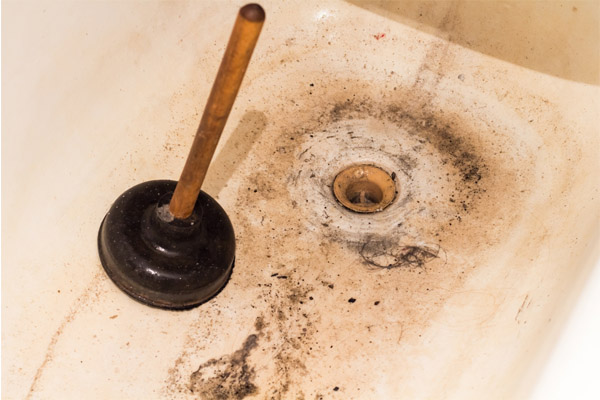How do you feel with regards to Why sewage is coming up through your bathtub?

Sewage back-up in the bathtub can be a stressful and unhygienic issue for any house owner. Not only is it inconvenient, however it additionally postures severe health dangers and shows underlying concerns with the plumbing system. Understanding why sewage is turning up with the bath tub is important for taking ideal action to deal with the issue efficiently.
Intro to the Problem
Comprehending the Issue
When sewer starts backing up into the tub, it's a clear indicator of a trouble with the water drainage system. The wastewater that should be flowing away from your home is rather finding its way back right into your living space, which can cause substantial damages and health hazards.
Prospective Reasons
Numerous aspects can contribute to sewage backup in the tub. From clogs in the sewage system line to problems with the plumbing framework, identifying the root cause is important for discovering a remedy.
Usual Reasons for Sewage Back-up
Obstructions in the Sewer Line
Among one of the most typical root causes of sewage backup is a clog in the sewage system line. This can occur due to the build-up of debris, oil, or foreign objects in the pipelines, avoiding correct circulation and triggering sewage to back up into your bathtub.
Tree Origin Intrusion
Tree origins seeking wetness and nutrients can penetrate drain lines through little cracks or joints. Gradually, these origins can expand and expand, triggering significant damages to the pipelines and bring about sewer back-up problems.
Aging Facilities
Older homes might have outdated plumbing systems that are more at risk to rust, fractures, and wear and tear. As pipes age, they end up being much more vulnerable to leakages and blockages, enhancing the probability of sewage back-up incidents.
Heavy Rainfall or Flooding
During periods of heavy rainfall or flooding, the sewer system may end up being overloaded with excess water, creating back-ups and overflows. This can lead to sewage supporting into tubs and various other components inside the home.
Health And Wellness Risks Associated with Sewage Back-up
Contamination of Water System
Sewer back-up can contaminate the water supply in your house, posturing a major health and wellness danger to you and your household. Direct exposure to contaminated water can result in stomach issues, skin infections, and various other illnesses.
Spread of Disease
Sewer has hazardous microorganisms, infections, and bloodsuckers that can trigger a series of diseases, including hepatitis, cholera, and gastroenteritis. Entering into contact with sewer or contaminated surfaces puts you in jeopardy of infection.
Mold and mildew Development
Wetness from sewer back-up can produce perfect problems for mold development in your home. Mold and mildew spores can aggravate respiratory issues and cause allergies in delicate people, making punctual cleanup necessary.
Indications of Sewer Back-up
Foul Odors
Undesirable odors emanating from drains pipes or components, particularly in the bathroom, might show sewer backup problems. These smells are typically strong and persistent, signaling a problem that requires immediate attention.
Slow Draining Fixtures
Tubs, sinks, and commodes that drain pipes gradually or otherwise in any way could be experiencing sewer back-up. If several fixtures are influenced at the same time, it's most likely that the problem stems from a typical factor, such as the major sewer line.
Gurgling Noises
Unusual gurgling or gurgling noises coming from drains when water is running somewhere else in your house are a measure of air caught in the plumbing system. This air build-up can result from sewer back-up and should be checked out promptly.
Immediate Actions to Take
Switching Off Water
In case of sewage back-up, it's important to turn off the water to avoid further contamination and damages. Situate the primary water shutoff valve in your home and closed it off till the concern can be settled.
Contacting an Expert Plumber
Taking care of sewer back-up is not a DIY work. Contact a licensed plumber with experience in dealing with sewage-related concerns to analyze the situation and carry out essential repair services or cleanings.
Preventing Contact with Polluted Water
Until the sewage backup is settled, avoid contact with polluted water to avoid the spread of germs and microorganisms. Wear safety gear if you need to remain in the afflicted area and clean your hands thoroughly later.
Preventive Measures
Normal Upkeep of Sewer Lines
Schedule routine inspections and upkeep of your sewage system lines to determine and deal with possible issues before they rise right into significant troubles. This can include cleaning debris, checking for tree root invasion, and fixing any kind of broken pipelines.
Setting Up Bayou Shutoffs
Take into consideration installing backwater valves in your plumbing system to stop sewage from receding into your home throughout periods of heavy rainfall or flooding. These shutoffs automatically close when water draws back up, protecting your residential property from contamination.
Appropriate Disposal of Home Waste
Prevent purging anything besides bathroom tissue and human waste down the commode to prevent clogs and clogs in the sewage system line. Dispose of grease, oil, and various other family chemicals appropriately to decrease the risk of plumbing problems.
Tidying up After Sewer Back-up
Disinfection Procedures
Thoroughly decontaminate and sterilize affected areas after sewage back-up to remove hazardous microorganisms and avoid mold and mildew development. Usage ideal cleansing products and protective equipment to make sure secure and efficient cleaning.
Remediation of Impacted Locations
Repair any damages to floor covering, wall surfaces, or components brought on by sewage back-up. Relying on the level of the damage, you might need to change carpeting, drywall, or other materials to recover your home to its pre-loss condition.
Why Is Water Backing Up in My Bathtub When I Flush My Toilet?
What to do about a sewer line clog
First, don’t bother with plunging. No amount of plunging will dislodge the clog in a sewer line. The clog is too far away. Plungers are for clogs in the toilet itself, not the sewer line. Plus, the most likely causes of a sewer clog are:
- Tree roots
- Flushed toys or feminine products
- Grease buildup
Those items don’t move easily. And in the case of tree roots, the roots need to be cut out of the pipe and the pipe will need to be repaired.
You’ll need a closet auger. A closet auger is a type of plumber’s snake with a protective cover to keep from scratching the delicate porcelain toilet. If the clog is further down, you may need to remove the toilet or use one of your cleanouts to get to the clog.
We also recommend doing a video inspection of the drain to ensure that the cause of the clog has been completely removed. Otherwise, you could have the same problem again in a few days or weeks.
https://mspplumbingheatingair.com/blog/why-is-water-backing-up-in-my-bathtub-when-i-flush-my-toilet

Hopefully you enjoyed our topic on . Thanks for taking the time to read our piece of content. Please take the opportunity to share this write-up if you enjoyed reading it. Thank you so much for your time invested reading it.
Click Here
Comments on “Top Reasons Behind Drainage Backflow in the Bathtub”